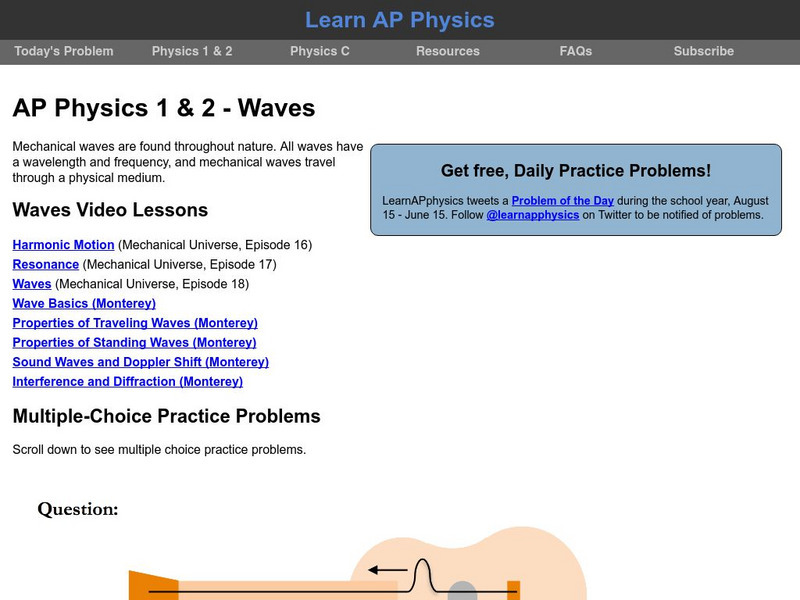Physics Classroom
The Physics Classroom: 2 Point Source Interference Patterns
The interference of two sets of circular waves with the same frequency and the same amplitude results in a standing wave pattern. These standing wave patterns are known as two-point source interference patterns since they result from the...
Khan Academy
Khan Academy: Wave Interference Review
Review the key terms and skills related to wave interference, including how to predict wave interference patterns.
Khan Academy
Khan Academy: Standing Waves Review
Review key terms and skills related to standing waves including how to find standing wave harmonics.
Open Curriculum
Open Curriculum: Wave Optics
Learn about the diffraction of light using the wave model and Huygen's principle.
Physics Classroom
The Physics Classroom:characteristics of a Transmitted Pulse
A reference page that explores boundary behavior of waves with an animation and examples.
Concord Consortium
Concord Consortium: Stem Resources: Making Waves
Learn how to make waves! Using a motion sensor, students will recreate distance vs. time graphs given in the lab. Lab gives a detailed procedure as well as questions that can be saved online.
Physics Aviary
Physics Aviary: Doppler Lab
This lab is designed to have students investigate the changes to wavelength and frequency that occur when the source of the waves is in motion. This video describes the lab: https://youtu.be/eCceYPBR6f4
TED Talks
Ted: Ted Ed: Particles and Waves: The Central Mystery of Quantum Mechanics
One of the most amazing facts in physics is that everything in the universe, from light to electrons to atoms, behaves like both a particle and a wave at the same time. But how did physicists arrive at this mind-boggling conclusion? Chad...
TED Talks
Ted: Ted Ed: The Physics of Playing Guitar
Guitar masters like Jimi Hendrix are capable of bending the physics of waves to their wills, plucking melody from inspiration and vibration. But how do wood, metal, and plastic translate into rhythm, melody, and music? Oscar Fernando...
Physics Aviary
Physics Aviary: Diffraction Lab
This lab is designed to allow students to look at the factors affecting the angle at which constructive interference occurs for waves passing through a two slit diffraction grating. This video helps explain the problem:...
Society for Science and the Public
Science News for Students: Wet Dog Physics
Describes the physics behind animals' ability to dry themselves by shaking to remove water.
Massachusetts Institute of Technology
Mit: Open Course Ware: Evolution of Physical Oceanography
A college course featuring instructor's notes and textbook resources on the history of physical oceanography.
CK-12 Foundation
Ck 12: Physics Simulation: Marina
[Free Registration/Login Required] Learn about the interference and diffraction patterns that result when a wave passes through one or two thin openings using this interactive simulation. A PDF worksheet and a video tutorial are also...
Science Buddies
Science Buddies: How Does Color Affect Heating by Absorption of Light?
Light is an example of an electromagnetic wave. Electromagnetic waves can travel through the vacuum of interstellar space. They do not depend on an external medium-unlike a mechanical wave such as a sound wave which must travel through...
CK-12 Foundation
Ck 12: Diffraction
[Free Registration/Login may be required to access all resource tools.] Students investigate diffraction of light and the interference patterns that are produced through constructive and destructive interference of the waves. Students...
CK-12 Foundation
Ck 12: Physical Science: Sound Waves
[Free Registration/Login may be required to access all resource tools.] Definition of sound, what sound waves are, how they are generated and what media they can travel through.
Learn AP Physics
Learn Ap Physics: Physics B: Waves
A site dedicated to help students prepare for the AP Physics B test. This specific site reviews waves including traveling waves, standing waves, resonance, speed of electromagnetic waves, Doppler shift, Doppler effect, interference,...
Cosmo Learning
Cosmo Learning: Physics Iii: Vibrations and Waves
A collection of video lectures from a physics course focusing on vibration and waves taught at the Massachusetts Institute of Technology. The course overviews topics dealing with mechanical vibration and waves with twenty-three lectures....
Ducksters
Ducksters: Physics for Kids: Wave Behavior
Kids learn about the behavior of waves in the science of physics including reflection, refraction, diffraction, polarization, absorption, and interference.
Ducksters
Ducksters: Physics for Kids: Wave Physics Glossary and Terms
Kids learn about the glossary and terms of waves in the science of physics including frequency, amplitude, transverse, mechanical, longitudinal, and more.
Ducksters
Ducksters: Physics for Kids: Behavior of Light as a Wave
Kids learn about the behavior of light as a wave in the science of physics including reflection, refraction, and diffraction.
Ducksters
Ducksters: Physics for Kids: Sound Wave Characteristics
Kids learn about the characteristics of sound waves in the science of physics including mechanical, longitudinal, pressure, and intensity.
Ducksters
Ducksters: Physics for Kids: Types of Electromagnetic Waves
Kids learn about the types of electromagnetic waves in the science of physics including microwaves, infrared, ultraviolet, radio, x-rays, and gamma rays.
Ducksters
Ducksters: Physics for Kids: Properties of Waves
Kids learn about the properties waves in the science of physics including amplitude, wavelength, frequency, period, and speed.
Other popular searches
- Waves Physics
- Waves Physics Tsunami
- Sound Waves Physics
- Energy Waves Physics
- Waves Physics High School
- Waves Physics Radio Waves
- Inquiry Based Physics Waves
- Waves Physics Practical
- Latitudinal Waves Physics
- Waves Physics Pictures
- Waves Physics Worksheets
- Waves Physics Gallery




















